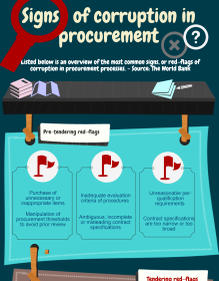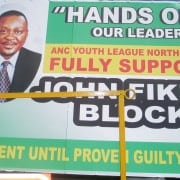|
Getting your Trinity Audio player ready...
|
Part three of Understanding corruption in public procurement takes a quick look at what’s involved in the tender process, then considers what and who influences the opportunities of corrupt practises in public procurement, and finally outlines the impact and damages of tender corruption.
Dodgy public procurement deals pop up frequently in the media and the practice is consistently reported to Corruption Watch. However, it is important to understand what factors influence the opportunities for corrupt practices and the actors who are involved.
According to the handbook The Basics of Integrity of Public Procurement, published by Norway’s Chr. Michelsen Institute, the suppliers of bribes (often companies) are influenced by the competitive environment they operate within. Preparing for a tender is time-consuming and costly, thus to offer a bribe is seen as a short-cut to be awarded a contract.
What’s involved in the government tender process?
Tenders are issued by national and provincial government departments and municipalities, and parastatals like Eskom, Spoornet and the SABC. They can usually be found advertised in the weekly government tender bulletin, or on the website of the body concerned. Government tenders are also generally advertised in major national newspapers, local newspapers, and on notice boards at government departments, post offices, police stations and elsewhere.
Companies bidding for a contract must be registered on the supplier or vendor database of the relevant state entity as this is a requirement for tender consideration. The government may go to these suppliers directly for smaller tenders.
Tenders are classified into two broad categories:
- Goods and services:
- For tenders under R30 000 the relevant government department will usually approach three registered providers for a quote;
- Tenders of more than R30 000 must generally be advertised to all subscribers;
- Tenders over R200 000 must be advertised and formally adjudicated.
- Building and engineering:
- Tenders over R2-million have to be adjudicated and formally advertised;
- Tenders below R2-million are seen as minor and under R100 000 as micro.
Tender documents vary from province to province, or between councils, so they should be contacted directly to ensure the forms are correct. Only completed original forms are accepted, and late submissions will be refused.
There are registered Tender Advice Centres nationally, but small companies can contact the Small Enterprise Development Agency (Seda) on 0860 103 703 for information.
To get registered, a businessperson can contact the government entity involved, which will ensure that he or she gets the right form as they may vary slightly. Forms must be accompanied by supporting documentation, such as a company registration certificate, a BEE certificate or a tax clearance certificate.
All requested information, such as the shareholders of the company, the regions in which it operates, and its previous supply chain management experience must be disclosed – but the information will remain confidential.
Completed forms must be posted or delivered by hand to the originator of the tender, and before the deadline.
When filling in tender documents, all sections must be completed in full. This includes disclosure of, for example, any connection with the tender board – if this fact is hidden it may open up an opportunity for corruption. All required forms and documentation will be listed in the tender document.
How is a tender awarded?
Before any awarding is done, the tender board will scrutinise all applications to ensure they comply with the requirements – those with information missing, such as no price, will be rejected. The board will then check to see that the applications comply with the specifications – those that do not are disqualified, and those that do are sorted into order of price.
The applications offering the lowest price will then be considered. At this stage the preference point system will come into play – by law, a preference point system applies to tenderers who are previously disadvantaged individuals (PDI), or women. Generally, for tenders over R50 000, 80% will be adjudicated on price and 20% on PDI or gender status. For tenders over R500 000, the 90% to 10% price system applies
The preference points claimed by the applicants are verified by the tender board, and the winner of the bid will be the one who complies with all the requirements and who achieves the best result on points. A contract may be awarded to a tenderer that did not score the highest number of points, but only under conditions laid down in section 2.1 (f) of the Preferential Procurement Policy Framework Act.
The tender board will notify successful applicants in writing. Those who are unsuccessful and who have an objection, may raise it with the department or government entity.
More detailed information may be found on the Seda website.
Because the procedures involved are complex, corruption may occur at any point along the way. Download our checklist to learn about the signs, or red flags, that may indicate the presence of corrupt activities.
What influences the opportunities for corruption?
- Sizes of contracts – bribes tend to be calculated as percentages of the total contract amount. Thus, the more money involved the higher the potential kickbacks.
- Complexity of technology – where there is high-level technology involved in a contract there tends to be greater difficulty in evaluating whether the price paid for a good or service is realistic or not.
- Type of sector involved – some sectors are more prone to corruption than other sectors. According to Corruption Watch’s data these sectors include :
- Schools
- Construction
- Health care
- Tertiary education
- Housing
- Discretion – the more a procurement officer can influence demand and preferences, the easier it is for that officer to take part in corruption.
- Lack of financial controls – if oversight systems are weak there is a lesser chance of being caught in corrupt acts, and thus leads to a higher level of corruption.
- Restricted access to information – if there is poor transparency involving executive decisions, especially if it is combined with a lack of public demand for information, this can have an increasing effect on the corruption level.
- Immediacy – the urgency to complete a contract leads to greater opportunities to inflate the price of a contract.
- Conflict of interest – the risk of corruption increases when public duties and the private interest of an involved actor are conflicting because there is a chance that the public position might be exploited to the advantage of private interests.
Actors involved in corrupt tender processes
Global watchdog Transparency International (TI), in its Handbook for Curbing Corruption in Public Procurement, says that corrupt deals require the involvement of different actors depending on the type of corrupt practises.
- Public official – the official extorts a bribe from a bidder before making an official decision in that bidder’s favour;
- Bidders (suppliers, contractors, consultants, and sub-contractors) – bidders wishing to do business with the government take the initiative to either offer/give a bribe/advantage to a government official in order to gain a favourable advantage over other bidders;
- Agents, middlemen, consultants, joint venture partners, subsidiaries – individuals who aim to manipulate a government decision-making process sometimes refrain from committing corrupt acts themselves but use agents/consultants/middlemen/local subsidiaries/joint venture partners for the actual corrupt activity;
- Witnesses – individuals who have information about corrupt activity in tender processes.
The impact of corruption in public procurement
According to TI, the main goal of public procurement is to satisfy the needs and interests of citizens. But when corruption occurs in tendering processes it can have damaging effects on the country because it diverts state funds away from public needs, often leading to service delivery protests, and erodes the publics’ trust in government.
Corruption in procurement encourages competition in bribery instead of competition for good quality or price. It has a harmful effect on honest bidders. It poses a danger to the economic development of the country and thus the poor of the country are the inevitable victims of this corruption.










